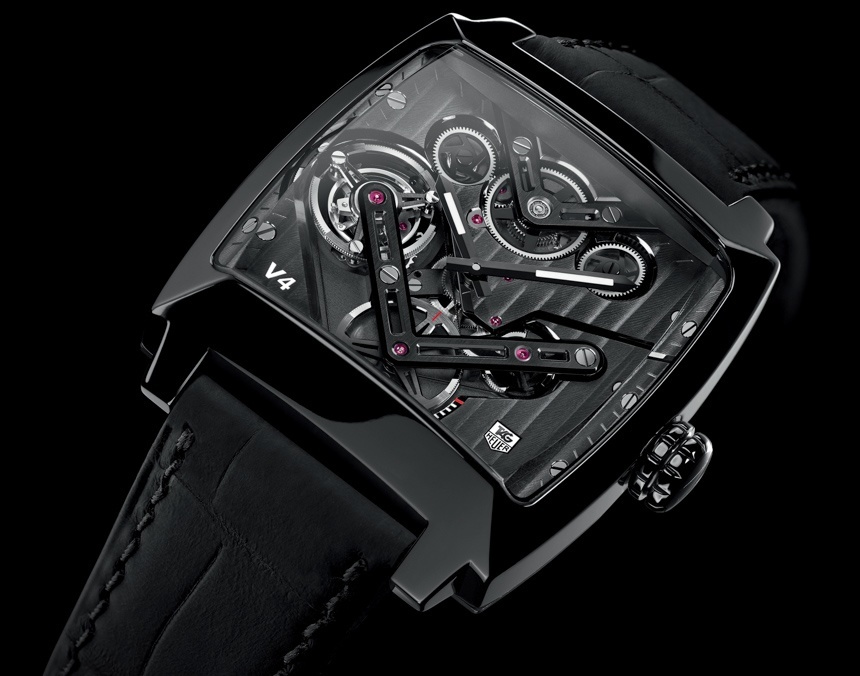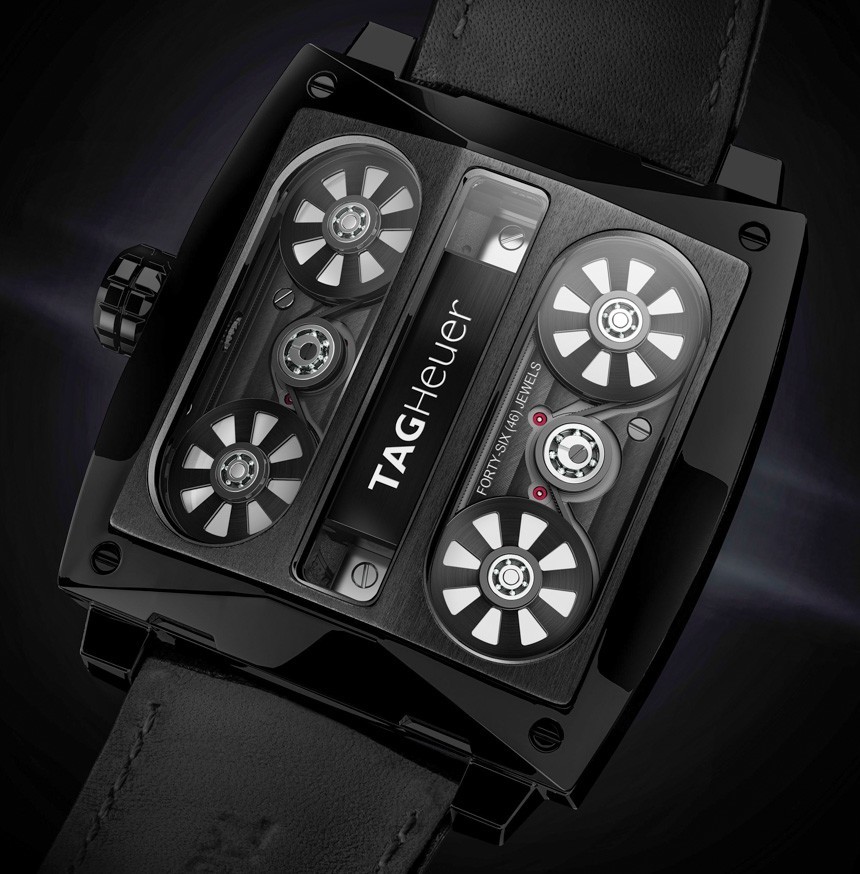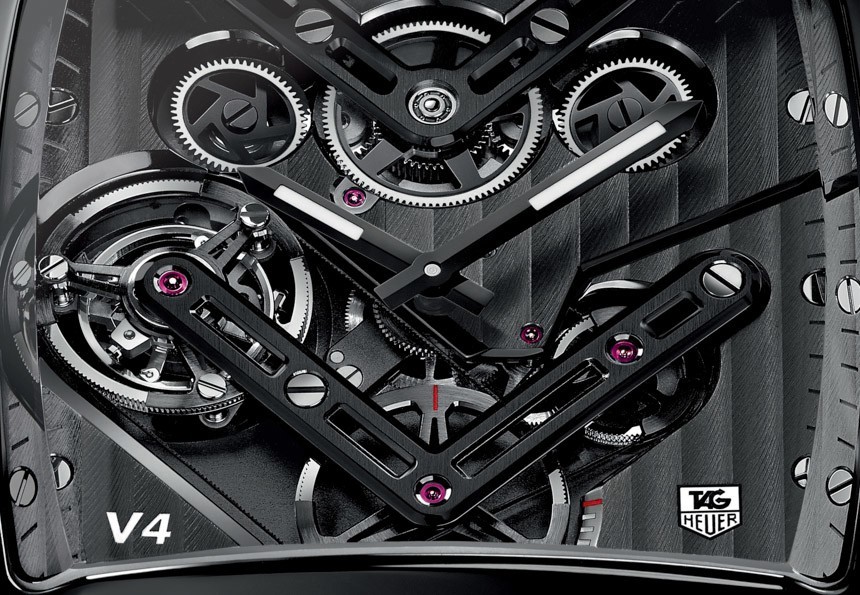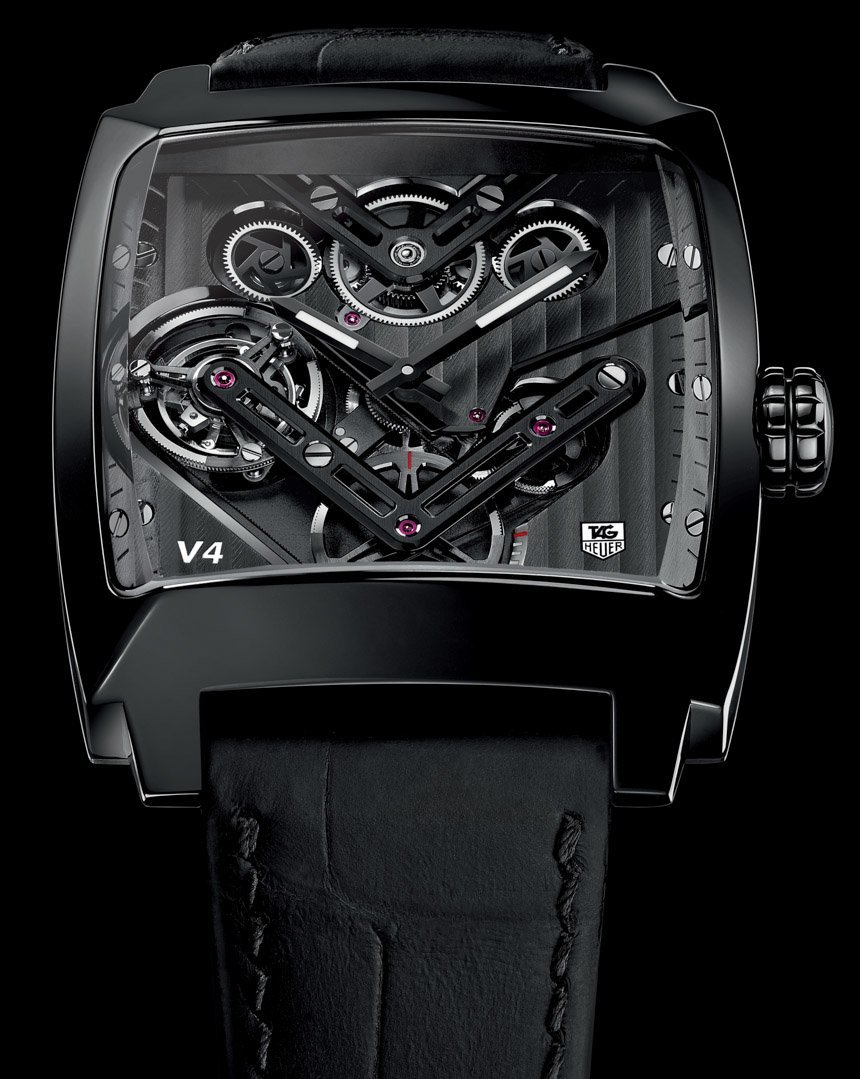
It is mind-boggling to think that one of Tag Heuer‘s most extraordinary creations, the Monaco V4 is already a bold ten years old. Today, we are looking at the piece with which the brand celebrates the tenth anniversary of what is one of the most technically impressive watches it has ever produced. The story goes that it was in 2004 when the brand presented a concept watch which, as a world first, utilized ultra-thin transmission belts in its movement. Called the V4, it was nothing short of a shocking concept which, somewhat embarrassingly, was a long way away from functioning without problems.
For quite some time–for 5 years, to be exact–it remained just that, a concept. And although it is a rare phenomenon to be equally as shocked by something that you have already seen (although I could think of a few exceptions which I will not elaborate on), Tag Heuer surprised us all in 2009, when they announced that the Monaco V4 would be commercially available – even if in very limited quantities and at a rather steep price of around $100,000. For further details about one of the latest non-tourbillon V4’s, check out Ariel’s hands-on article here. And when I said “non-tourbillon,” you might have guessed just how exactly Tag Heuer will celebrate the 10th anniversary of this piece: that’s right, by revealing a new and further enhanced version, called the Monaco V4 Tourbillon, the world’s first micro-belt driven one-minute tourbillon. Talk about coming a long way from a problematic concept to a most impressive horological achievement!

The watch is still operated by four barrels, mounted on a unique, V-shaped main plate, reminiscent of the V-configuration of engines found in sports cars and some bikes as well. From our perspective the truly interesting bit is that these barrels are mounted on ball-bearings (those tiny little “dots” that you see above, by the center of the four barrels are in fact the bearings) and that they are connected by incredibly small and yet rather strong transmission belts. Actually, Tag Heuer spent most of those five years between the 2004 concept and the 2009 “commercialized” version looking for a way of manufacturing these tiny little belts.
The problem was that these have to be incredibly precisely manufactured–to give you an idea on the scale of these things the thinnest belt is a mere 0.07 millimeter “thick”–so that they would reliably drive the wheels and pinions under all circumstances. Other major sources of issues included the variations in heat and other external factors, as well as the mid-to-long term durability of these truly microscopic components. Tag Heuer eventually found the answers to all these issues and treats them extremely confidentially. What is clearly visible though through the sapphire front and back of the V4 Tourbillon’s titanium case is that these transmission belts, as their name implies, serve as the vehicle that transfers drive from one wheel to another, and hence also to the pinion of the tourbillon.

Speaking of which, let’s cut to the point that makes this year’s V4 a true novelty, and also a more important advancement over any of its predecessors: it’s single-axis, one minute tourbillon. I will admit that the trend of putting a tourbillon on just about anything that is considered capable of fetching six-figure prices is something I feel I need some strong medication for… and yet, I really enjoy the technological and temporal contrast this creates in the V4. On one hand there is the tourbillon, this two-centuries old–and by now bafflingly ubiquitous–invention, which Breguet designed to be so amazing and so arresting that it just fails to lose its power to impress no matter what. On the other hand, however, there is this very impressive sci-fi inspired movement (which Tag Heuer partially redesigned for the V4T) with its matte black belts stretching between comparably monumental gears and skeletonized bridges, all done in blacked-out metal…
And the end result is a watch that looks rather cold and intimidating, and yet also something that deserves to be appreciated, even if such on-the-wrist technocracy is not one’s cup of tea. The two large, V shaped and open-worked bridges and the beveled openings highlight the wheels which seem to be floating scattered around the dial, without any obvious connection between one another. When I first saw a V4 “in the metal” what amazed me most was just how minuscule the belts actually were–no image can truly imitate how difficult it really is to properly spot them with the naked eye.

One aspect where I would expect to see some further advancements–or rather, more creativity–concerns the decoration of these movements. Since these haute horologerie pieces are hand decorated and assembled by the brand’s master watchmakers, I am sure there would be a way to implement newer designs. What I mean by this is that while the tourbillon fits surprisingly well into this otherwise futuristic environment, I find that the Côtes de Genève decoration on the plates shows some lack of imagination, meaning that I feel some new, more modern patterns could be created that would look as elegant and refined as the “Genevan stripes”, and yet would not remind us of nearly all traditional pieces out there, showcasing this decoration in one way or another.
Even with that in mind, Tag Heuer has not only created what appears to be most refined Monaco V4 thus far, but also the first ever belt-driven tourbillon. With that, the V4 strikes its third time as being positively surprising: after the bold idea behind the concept watch of 2004, then its commercialization in 2009, and now the rather unorthodox approach to something as traditional and as iterative as the single-axis tourbillon. Considering Tag Heuer’s developments regarding its high-tech chronograph movements I wonder if–or rather when–will there be a belt-driven chronograph… But until then, the V4 Tourbillon is here to carry on this microscopic world of belt-driven fine mechanics. The V4T will be available later this year and will be priced around $170,000. tagheuer.com
